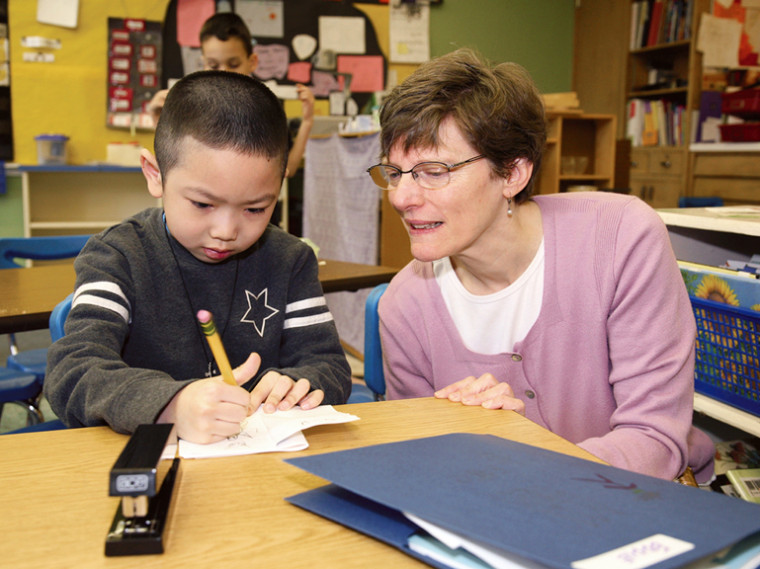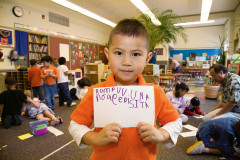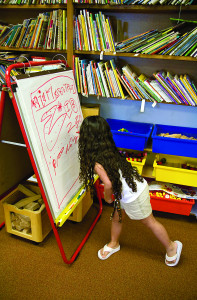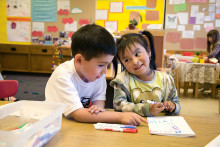Teaching Literacy Across the Life Span
Open gallery

Professor Ruth Shagoury helps students of all ages—from preschool to graduate school—unlock the joys of reading and writing.
by Genevieve J. Long
Photography by Jim Whitney
“Woof, woof!” barked the 5-year-old under Ruth Shagoury’s desk. He wasn’t playing, but using the communication tools he knew. Kindergarten was a new environment for the child from rural New Hampshire. When her student was at home, Shagoury learned, he spent most of his time outside with the family dogs.
“He didn’t really speak,” she says softly, remembering the child’s amazing story. Shagoury set out to immerse her student in human language. “I did what I’d do with an infant,” she says. “I read to him, talked to him, exposed him to language.” As a young teacher, Shagoury was already practicing the literacy philosophy she now teaches graduate students: accepting each student’s abilities (no matter how limited); teaching literacy through immersion; and encouraging speech, reading, and writing skills to unfold in developmentally appropriate ways.
Today Shagoury is the Rogers Professor of Education in the Lewis & Clark Graduate School of Education and Counseling. Shagoury—along with Andie Cunningham MAT ’00, an instructor at the graduate school—coordinates the Department of Teacher Education’s Language and Literacy Program, which leads to Oregon reading specialist certification. The author of 12 books on writing, reading, and teaching, Shagoury studies how children acquire literacy, including how second-language learners become literate in English.
Though she now teaches graduate students, Shagoury hasn’t stopped working with children. She volunteers in classrooms from prekindergarten through high school. ”I look at literacy across the life span,” she says. Classroom practice grounds her research and teaching.
Discovering a Passion for Research
Shagoury never intended to become a teacher. She majored in art at Colby College in Maine and planned to become an artist. “It turned out I wasn’t that great an artist,” she laughs. Later, divorced with two young children, she earned her master’s degree in education from the University of New Hampshire so she could return to work.
Her students inspired Shagoury’s interest in literacy. “So many kids had reading problems, I decided to become a reading specialist,” she says. At the time, researchers were learning that writing could increase children’s reading comprehension. “I could help troubled readers by having them write and make meaning,” Shagoury says.
As a graduate student, Shagoury joined a classroom research project involving teachers and students. She fell in love with “being in classrooms, learning ethnography, writing up findings.” After receiving her PhD from UNH, she decided to leave her native New England and applied for jobs around the United States, including Lewis & Clark. “The job description seemed written just for me,” she says.
After interviewing, she canceled her appointments at other schools. A week later, she got the job.
Literacy as a Developmental Process
As the barking kindergartner illustrates, literacy is a developmental process that takes place in a social context. Shagoury’s student was learning language from his peers—they just happened to be canine.
According to Shagoury, adults’ main role in language acquisition is providing an environment rich in spoken language, books, and paper and crayons for drawing and scribbling—early writing attempts. Learning to read and write, Shagoury says, is similar to learning speech. “We talk back to babies’ babbling as if it makes sense to us, honoring that their words will come—and they do,” she says. “Writing is also a process of language acquisition and development. There’s a misconception that writing (and reading) need to be correct from the start, and that teaching isolated skills in a rigid lockstep manner will lead to literacy. Developmentally, children write before they read; they can encode language before they can decode.”
To watch Shagoury work is to sense her delight in the process. Conferring with 6-year-old Eddie, Shagoury watches as he writes captions for a picture he has drawn. Eddie’s first language is Cantonese; he spoke little English when school started in September. Now, in May, he is clearly communicating with Shagoury. He draws, points, and exclaims, “My!”

In graduate classes and teacher workshops, Shagoury reveals the developmental steps in acquiring literacy. “I want to make the magic less invisible,” she says. For example, young children’s scribbles imitate adult handwriting; English language learners sometimes use letters from their first language to complete a word. When Eddie arrived at school, he babbled at his English-speaking teachers. “It wasn’t English or Cantonese,” Shagoury says. “We think it’s how English sounded to him.” Now he writes in both Chinese and English. Knowing that his English-language acquisition, reading, and writing will unfold similarly to speech acquisition helps his teachers see miracles rather than mistakes.
Respecting children’s efforts encourages them to keep writing, even when their repertoire of letters and words is small. Early in her career, Shagoury watched a student write c-a-t repeatedly. She observed, “David, you’re writing ‘cat’ a lot.”
“Oh yes,” he said. “I’m writing about all the cats we’ve had. There was Kitka,” he said, writing c-a-t. “And Minutka,” he added, writing c-a-t again. David’s strategy, Shagoury realized, was to represent each cat with the letters he did know. This let him write about an important topic. Like a baby learning to talk, his stories incorporated more letters and words as he learned them.
Because literacy develops in the larger context of a child’s environment, popular methods like flashcards and “smart baby” videos are ultimately ineffective, Shagoury says. In teaching children to recognize individual letters and words, these systems divorce words from context. She compares it to reading a second language when you’re not fluent: “When I read French,
I can decode each word, but I struggle to get the whole meaning.” Kids who don’t fully understand what they read are at risk of what teachers call “the fourth-grade slump.” Shagoury explains, “Fourth or fifth grade is when understanding content becomes more important. If kids are just ‘word calling’—reading sounds or words they recognize without comprehending their meaning—they’re in trouble.”
Rather than teaching for standardized test success, Shagoury says, “I want kids to see that literacy can help them right now—today!—in their own lives. I don’t want them to graduate from college knowing how to read but never reading. ‘Ludic reader’ is a term I like—ludic comes from the Latin for ‘to play.’ I want kids to see reading as a ludic activity.”
Supporting Student Success
To support the learning process, Shagoury emphasizes treating students with respect. Andie Cunningham teaches and coauthors books with Shagoury. “Students know Ruth will listen deeply to them, respect their work, and celebrate their successes,” she says. “She joins them in learning rather than telling them where they went wrong.”
Shagoury’s methods are based on identifying strengths. She gives graduate students samples of kids’ writing, asking, “What does this kid know? Tell me what she’s figured out.” For example, 5-year-old Alana used apostrophes in a story. Although they weren’t placed correctly, she used them only in words showing possession, a clear sign that she was starting to grasp punctuation conventions. Kelly Petrin MAT ’07, a Head Start teacher for Portland Public Schools, says, “Ruth demonstrates the same respect and encouragement with the youngest learners that she gives her university students. The respect she shows students helps them feel safe to risk change.”
Change is what Shagoury, her graduate students, and her teaching partners want. After noticing what a child knows, the next question is, “What do you want to work on?” According to Shagoury, “You’re not complacent about your students. You’re excited by where they are, but always nudging them forward.”
Trusting and Encouraging Teachers
Shagoury also believes in trusting teachers to solve classroom problems and improve educational practice. “If we want to learn about education, we have to be in teachers’ classrooms. My job as coresearcher—or interested friend—is to tell them what I see, but teachers solve problems through observing, writing about their problems, and figuring out solutions.”
She urges teachers to turn questions into research opportunities. “With my graduate students, I talk about mining their tensions,” Shagoury says. “What’s keeping them awake at night?” She recommends collecting data that can be used to find solutions. Cunningham says, “Ruth believed in my journey as a teacher from the moment I entered her classroom. It was from her belief that I began believing, trusting, and journeying with my own students.”
Because she encourages teachers to observe and innovate, Shagoury objects to one-size-fits-all education models. “Teachers are told to teach the same way, rather than watching students and seeing what they do,” she says. “But teachers and caregivers are experienced in reading the subtle cues and behaviors of the children with whom they spend their days.”

She also encourages teachers to become literacy leaders. “Ruth pushed me to become a writer myself,” says Katie Doherty MAT ’07, a sixth-grade teacher at Ron Russell Middle School in Portland. “Having read her books and articles, I was certain that I had nothing of such importance to share, but she continued to push me.” Because of Ruth’s encouragement, Doherty has had several articles published and is a presenter for Choice Literacy.
Shagoury’s belief in students’ ability to learn and in the value of teachers’ observations and reflections is an important gift to literacy education. In the course of her career, Shagoury has created a literacy community that spans all ages and holds promise for the future of education.
Genevieve J. Long is a Portland writer who specializes in education and health care.
More L&C Magazine Stories
Lewis & Clark Magazine is located in McAfee on the Undergraduate Campus.
MSC: 19
email magazine@lclark.edu
voice 503-768-7970
fax 503-768-7969
The L&C Magazine staff welcomes letters and emails from readers about topics covered in the magazine. Correspondence must include your name and location and may be edited.
Lewis & Clark Magazine
Lewis & Clark
615 S. Palatine Hill Road MSC 19
Portland OR 97219


